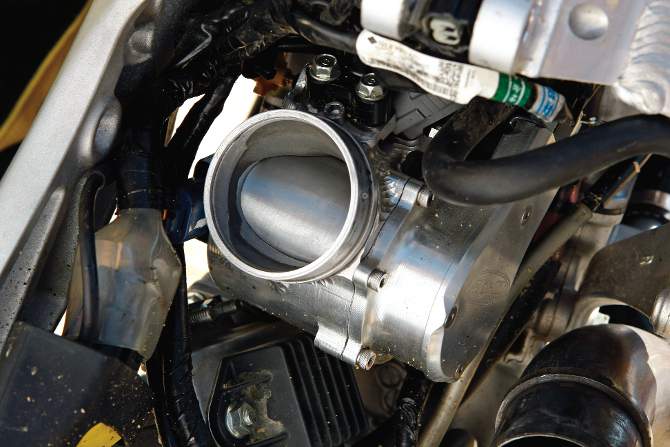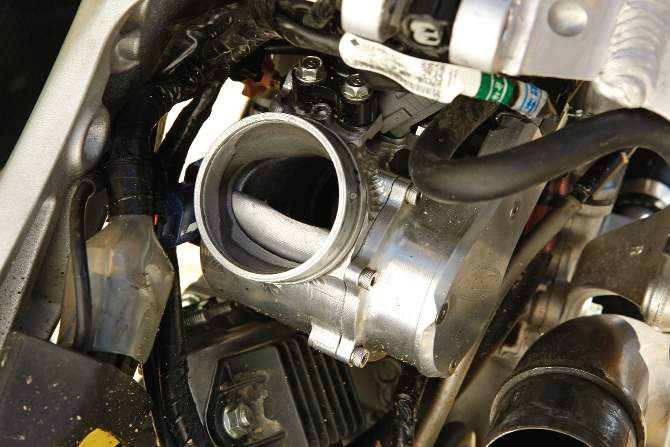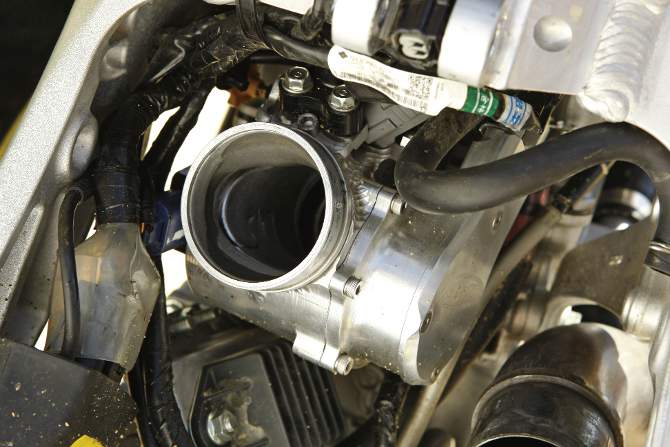INSIDE SECRETS OF THE INNOVATIVE R&D GENIUS THROTTLE BODY

You’ve heard of Dean Dickinson?you just don’t know it. Dean’s dad, Rudy, was one of the pioneer tuners of the two-stroke era. What Rudy learned, he passed on to his sons Dean and Rudy Jr. (all three were successful racers in their day).
Dean is a Gyro Gearloose inventor?and we don’t mean that as a slam. Dean sees problems as no problem. He’s more than a technician, more than an engineer and more than a mechanical genius. So, where would you have heard of Dean Dickinson? Let us list the ways.
(1) The company that Dean’s dad built and Dean inherited is called R&D Racing. R&D fielded the official Suzuki minicycle team for 13 years?and, in the process, sponsored many of the biggest names in motocross and built some of the fastest 85cc, 105cc and 125cc two-strokes in the world.
(2) When four-stroke engines came on the scene, Dean invented a continuous wave of products to make the Keihin FCR carb work like a Swiss watch. In short order, Dean Dickinson became the guru of carburetors. Dean’s products included the R&D Power Pump, Power Bowl, Flex-Jet and Power Spring. If Keihin carbs hadn’t been replaced by fuel injection, Dean would be sitting on a carb empire today.
(3) With the arrival of fuel injection, Dean turned his attention from carburetors to throttle bodies, which is where the “genius” nomenclature comes in, because Dean developed the R&D Genius throttle body. Not only did he build it in his little workshop?without financial support from any corporations?but he got the Geico Honda team of Justin Barcia and Eli Tomac to use his Genius throttle body in the 2012 AMA 250 Nationals. By the time the 2013 season gets underway, his throttle body could be on most of the bikes on the starting line.

Closed: The secret of the Genius is its unique barrel-shaped design.
FROM CARBS TO THE STROKE OF GENIUS

Dean’s carburetor experience gave him an intimate understanding of the problems associated with fuel delivery on motocross bikes. And, given that most motocross bikes use almost identical fuel-injection throttle bodies, once he cracked one case, he cracked them all. This isn’t so in other motorsports, where throttle body inventions have been springing up since the development of the Bendix Electrojet for the 1957 Rambler Rebel.
On fuel-injected engines, the throttle body is the part of the air intake system that controls the amount of air flowing into the engine. The throttle body is located between the air filter and the intake manifold. It is controlled by a butterfly valve. A butterfly valve is a disk that opens and closes the venturi of the throttle body’s bore. The throttle body controls the air, and the digitally controlled injector nozzle delivers the fuel at the point where it can be mixed and misted by the air.
Butterfly valves are cheap to produce and lightweight, but they aren’t very aerodynamic. Whether the throttle is open or closed, the disc is always present in the airflow. It not only creates turbulence, but it splits the air stream into upper and lower halves, with the upper half getting the vast majority of fuel droplets from the injector. Making matters worse is that the presence of a metal barrier in the center of the venturi creates a pressure drop at the exact moment when you’d like to have the air velocity at its maximum. Thus, even as far back as the ’57 Rambler, inventors have been working overtime coming up with ways to get rid of the butterfly valve.

Half throttle: As it rotates open, the elliptical barrel disappears.
THE FUTURE OF THE THROTTLE
When Dean Dickinson set out to reinvent the EFI throttle body, he had a series of goals to accomplish.
(1) Bye-bye butterfly. Dean wanted to banish the butterfly completely. Other than its simplicity and low cost, it is largely a negative factor in fuel management.
(2) Dam the slide. Although many inventors have taken the slide from the old-school carb and attached it to the throttle body, Dean didn’t see it as an improvement over the butterfly. When a slide is fully open, it is at its best. But, at 1/8-, 1/4-, 1/2- or 3/4-throttle openings, it is a dam that blocks airflow and disturbs the smooth movement of the fuel. Plus, a slide has air pressure against it as the engine accelerates. This air pressure creates stiction that requires rollers or bearings on the slide to overcome the drag. Dean didn’t want to dam up the air pressure; he wanted to use it for good.
(3) To achieve maximum air velocity , proper fuel misting and minimal turbulence, Dean wanted to invent a device that would replace the butterfly, utilize the air pressure to help open the gate and minimize turbulence, which is the enemy of maximum air quantity.

Wide open: When fully open, there are no obstructions in the venturi.
REINVENTING THE WHEEL
Dean’s stroke of genius was to design a rotating gate. What is a rotating gate? Instead of a flat slide that is pulled vertically out of the venturi or a butterfly valve that flips out of the way, Dean designed an elliptical barrel that rotates inside the throttle body’s venturi. The elliptical barrel rotates completely out of the way, and because of its smooth shape, the air flows over it with less disturbance. More significant, Dean’s rotating barrel is pushed open by the air pressure generated by the gulping of the piston.
As you open the throttle, the elliptical barrel rotates out of the way?and by full throttle, it not only disappears, but becomes the smooth bottom surface of the throttle bore. It’s a simple, clever design that eliminates the obstruction of a butterfly and the drag of a slide.
DESIGN ELEMENTS AT WORK
The genius of the Genius throttle body is that it addresses more than just the turbulence problem; it works in a myriad of other ways.
Keyhole. The Genius bore has a keyhole opening at the top that allows small amounts of air through at low throttle settings. This is important on a four-stroke engine, because thumpers don’t have the vacuum pressure of a two-stroke. The small keyhole helps the four-stroke get fuel when butterflies and slides are still bogging.
Oval bore. Because the rotating gate becomes a part of the throttle body’s structure when wide open, the bore can be made round, oval, tapered or a combination.
Mapping. If a throttle body flows more air and more fuel, it needs completely different mapping. R&D plans to package every Genius throttle body with a custom-mapped Vortex ECU, which will have 10 maps built into it to ensure that the user can find the perfect setting with little more than the twist of a screwdriver.
Manufacturing. Although the ultimate goal is to cast the Genius throttle body, that makes no sense for a prototype product that is barely ready for mass marketing. Each unit is CNC-machined. Once the Genuis’ basic component part is finished, it accepts all the electronic hardware from the customer’s stock Keihin EFI throttle body. The only part it won’t accept is the Throttle Position Sensor (TPS), because Dean believes that his chosen TPS is better than the stockers?thus he provides it along with the Vortex ECU.
Fitment. Because of the complexity of the part and its electronics, customers will have to send their stock throttle bodies to R&D to have the electronics transferred. This is a simple job for an expert, and turnaround time should be minimal. The completed throttle body and ignition ECU will be bolt-on parts to the end user.
Price. This isn’t a cheap mod. It involves a high-tech and complex CNC-machined piece, new electronics and some manual labor. If we were guessing men, we’d say that it will cost as much as, or more than, an exotic titanium exhaust system?most likely in the $1500 range, but the price is yet to be determined.
HOW DOES THE R&D GENIUS WORK ON THE TRACK?

The stock Keihin throttle body uses a butterfly valve. It not only blocks air flow, but it splits the air into two separate streams?one that gets fuel and one that doesn’t.
There are only a handful of R&D Genius throttle bodies out there?mostly in the hands of the Geico Honda team. But, MXA has had one on our 2013 Honda CRF450 for quite some time. Here are the test rider reports and dyno tests.
First and foremost, the Genius throttle body is designed to improve low-end power, partial-opening throttle response and pick up through the midrange. It is logical that the smooth-flowing characteristics of the Genius design will have the biggest effect when engine vacuum is low and the fuel misting equation is confused. Once the throttle body is wide open, the Genius can only add a little extra to the maximum flow of a butterfly and not much more than a slide?since they are all basically out of the way.
Every MXA test rider?and we tested with eight different riders from Novice to Vet to AMA Pro?raved about the added power down low. And we aren’t talking about the irritating bark that some bikes have off idle. The Genius throttle body torqued up the response so much that you could feel it in your wrist. Suddenly, test riders were metering their throttle hands to maximize thrust instead of just winging it. It was a clear-cut improvement in brain-to-throttle control.
Because the Genius-equipped CRF450 made more horsepower at low rpm and specifically at small throttle openings, it made more power by basic geometric progression as the rpm and throttle openings increased. Even though we switched back and forth between a stock CRF450 and the Genius-equipped CRF450, most test riders admitted that they didn’t need to ride the stocker to feel the difference?it was that obvious.
THE DYNO EQUATIONS
Although we could have settled on a basic dyno run, it wouldn’t have told us much more than how much power the Genius throttle body made at a wide-open setting. That wasn’t what we were interested in. Because of the unique shape of the Genius’ rotating gate, it does its best work when the throttle is only partially open. Luckily, we had a solution for the dyno tests. We would run a standard dyno test, but then we would lock the throttle down so that it could only be turned to 50 percent open, 20 percent open, 10 percent open and 5 percent open. This would allow us to test the difference between the stock throttle body and the R&D Genius at partial settings.
100 percent open: On the traditional dyno run, the Genius made 1.92 horsepower more at a wide-open setting. That is a good increase for a throttle body.
50 percent open: With the throttle locked in place at 50 percent open, the Genius made 3.93 horsepower more than with the stock throttle body.
20 percent open: At 20 percent throttle opening, the Genius made 6.36 horsepower more.
10 percent open: With the throttle locked in place at 10 percent open, the Genius made 2.70 horsepower more than the stocker.
5 percent open: With the throttle cracked to 5 percent open, the Genius made 2.14 horsepower more than the stock throttle body.
Don’t be too impressed by the individual horsepower numbers at 50 percent and 100 percent. Although they are impressive gains, the smaller horsepower numbers at 5 percent and 10 percent were a 60 percent increase in power for the Genius over stock. Gaining 2 horsepower out of a possible 52 isn’t nearly as significant as gaining 6 horsepower out of a possible 13.
WHAT DO WE REALLY THINK?
Number one, we think it works. Number two, we think it works really well. Number three, if you think you have done everything you can to make your bike fast, you haven’t scratched the surface until you try the R&D Racing Genius throttle body. At the moment the Genius throttle body remains a special part that has only be used by a handful of riders and racers. It will be mass produced soon, but to find out more go to www.r1dean.com.





Comments are closed.